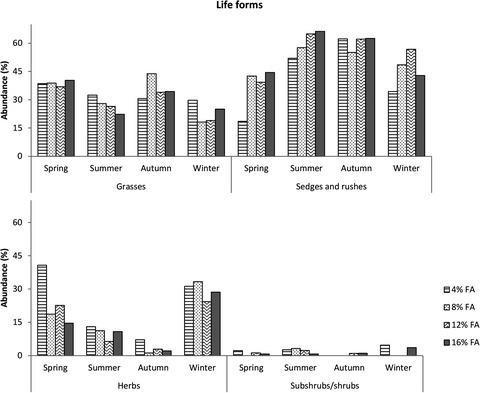当前位置:
X-MOL 学术
›
Austral Ecol.
›
论文详情
Our official English website, www.x-mol.net, welcomes your feedback! (Note: you will need to create a separate account there.)
Seasonal patterns of endozoochory by cattle in subtropical grassland in southern Brazil
Austral Ecology ( IF 1.5 ) Pub Date : 2021-06-02 , DOI: 10.1111/aec.13054 Graziela Har Minervini Silva 1 , Gerhard Ernst Overbeck 1, 2
Austral Ecology ( IF 1.5 ) Pub Date : 2021-06-02 , DOI: 10.1111/aec.13054 Graziela Har Minervini Silva 1 , Gerhard Ernst Overbeck 1, 2
Affiliation

|
Seed dispersal influences plant community dynamics and regeneration. Zoochory by cattle is a particularly important type of dispersal in grasslands, but still poorly understood in subtropical grasslands. We studied endozoochory in a native grassland area with different grazing intensities, defined by distinct forage allowance levels. On one day in each of the four seasons of the year, dung samples were collected and kept in a greenhouse for germination over one full year. At each dung collection date, a survey of reproducing plants was conducted to relate the species composition of seed within dung to the community in dispersal phase. We used randomisation tests to compare grazing intensities and seasons in terms of dung community richness, abundance and composition. We recorded 93 species in the dung samples, with 65 species in the spring samples, 61 in summer samples, 45 in the autumn samples and 37 in the winter samples. Of the 90 species identified in the vegetation, almost 50% (43 species) also occurred in dung samples. Graminoid herbs presented the largest number of species in all samples. Grazing had no effect on overall seed and species number, but was related to compositional differences in the cattle dung communities. Grazing also influenced the species composition in relation to life cycle, by the increase of annual species at the extremes of our grazing gradient (very high or very low grazing intensities). We conclude that endozoochory by cattle is an important process for the dispersal of native species in the studied system, with potential applications in grassland management and restoration. A better understanding of the strategies involved in seed dispersal is essential to improve knowledge about grassland vegetation regeneration and maintenance.
中文翻译:

巴西南部亚热带草原牛体内动物寄生虫的季节模式
种子传播影响植物群落动态和再生。牛的动物传播是草原中一种特别重要的传播类型,但在亚热带草原中仍然知之甚少。我们在具有不同放牧强度的原生草原地区研究了动物内源性动物,放牧强度由不同的草料津贴水平定义。在一年四个季节的每一天的一天,收集粪便样本并保存在温室中,以便在一年内发芽。在每个粪便收集日期,对繁殖植物进行调查,以将粪便中种子的物种组成与扩散阶段的群落联系起来。我们使用随机测试来比较放牧强度和季节的粪便群落丰富度、丰度和组成。我们在粪便样本中记录了93种,在春季样本中记录了65种,夏季样品 61 个,秋季样品 45 个,冬季样品 37 个。在植被中鉴定的 90 种物种中,近 50%(43 种)也出现在粪便样本中。在所有样品中,禾本科草本植物的种类最多。放牧对整体种子和物种数量没有影响,但与牛粪群落的组成差异有关。放牧还影响了与生命周期相关的物种组成,通过在我们的放牧梯度的极端(非常高或非常低的放牧强度)增加一年生物种。我们得出结论,牛的内源性动物是研究系统中本地物种传播的重要过程,在草地管理和恢复方面具有潜在应用。
更新日期:2021-06-02
中文翻译:

巴西南部亚热带草原牛体内动物寄生虫的季节模式
种子传播影响植物群落动态和再生。牛的动物传播是草原中一种特别重要的传播类型,但在亚热带草原中仍然知之甚少。我们在具有不同放牧强度的原生草原地区研究了动物内源性动物,放牧强度由不同的草料津贴水平定义。在一年四个季节的每一天的一天,收集粪便样本并保存在温室中,以便在一年内发芽。在每个粪便收集日期,对繁殖植物进行调查,以将粪便中种子的物种组成与扩散阶段的群落联系起来。我们使用随机测试来比较放牧强度和季节的粪便群落丰富度、丰度和组成。我们在粪便样本中记录了93种,在春季样本中记录了65种,夏季样品 61 个,秋季样品 45 个,冬季样品 37 个。在植被中鉴定的 90 种物种中,近 50%(43 种)也出现在粪便样本中。在所有样品中,禾本科草本植物的种类最多。放牧对整体种子和物种数量没有影响,但与牛粪群落的组成差异有关。放牧还影响了与生命周期相关的物种组成,通过在我们的放牧梯度的极端(非常高或非常低的放牧强度)增加一年生物种。我们得出结论,牛的内源性动物是研究系统中本地物种传播的重要过程,在草地管理和恢复方面具有潜在应用。



























 京公网安备 11010802027423号
京公网安备 11010802027423号